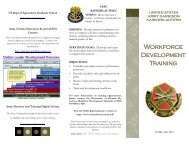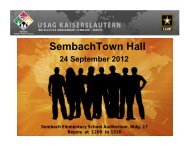CUSTOMER GUIDE - US Army Garrison Kaiserslautern
CUSTOMER GUIDE - US Army Garrison Kaiserslautern
CUSTOMER GUIDE - US Army Garrison Kaiserslautern
Create successful ePaper yourself
Turn your PDF publications into a flip-book with our unique Google optimized e-Paper software.
15<br />
<strong>US</strong>AG <strong>Kaiserslautern</strong> DPW Customer Guide<br />
b. Appoint building energy monitors to ensure proper handling of the facilities in regard to energy and water<br />
conservation (see checklist at appendix H).<br />
c. Submit service orders to request repairs to eliminate waste of energy and water.<br />
2-22. DPW Support. The DPW provides training for building energy monitors and information material on energy<br />
conservation. Please contact the Operations and Maintenance Division at DSN 483-8607.<br />
Section VIII Environmental Support<br />
2-23. General. Environmental protection is everybody’s mission, from the highest to the lowest levels of<br />
command. U.S. policy requires that all military departments comply with “environmental pollution control<br />
standards of general applicability in the host country.” Failure to comply with environmental pollution control<br />
standards may subject the offender to host nation criminal and/or civil penalties.<br />
2-24. Appointment of Environmental Officers (EO) or Environmental Points of Contact (EPOC). All units<br />
are required to appoint EOs or EPOCs based on whether they handle hazardous materials (HM) and generate<br />
hazardous wastes (HW) or not. That means, all units handling HM/HW are required to appoint EOs; administrative<br />
units may only need to appoint an EPOC to oversee conformance with the <strong>Garrison</strong> Environmental Management<br />
System (EMS).<br />
2-25. Unit Environmental Officer Handbook. The Environmental Management Division publishes a unit<br />
environmental officer handbook that details the environmental duties and responsibilities of commanders and unit<br />
environmental coordinators and gives them a simplified guidance on how to do their job properly. The handbook<br />
can be obtained from the Environmental Management Division, bldg 3104, Daenner Kaserne, or by calling DSN<br />
483-6059.<br />
2-26. Environmental Seminars and Training.<br />
a. The Environmental Management Division provides training for the community as follows:<br />
(1) Newcomer Briefings. An environmental overview is provided during newcomer in-processing training<br />
every week.<br />
(2) Unit Environmental Officer Training. Once per year and on as-required basis, unit environmental<br />
officers are trained on general environmental issues and their responsibilities.<br />
(3) Training on hazardous material/waste handling and disposal and other environmental topics can be<br />
provided upon request. Contact the Environmental Management Division at DSN 483-6059 for special<br />
requirements.<br />
b. The Environmental Management Division also coordinates training offered <strong>US</strong>AREUR wide. Units will be<br />
notified of schedules and slots by separate correspondence.<br />
2-27. Hazardous Material/Waste Spills. Spills are divided into two categories: major and minor spills.<br />
a. Definitions:<br />
(1) Major spill is a discharge of 25 gallons or more of petroleum product which is not in a contained area<br />
or which poses a threat to public health or animal, plant, or marine life.<br />
(2) Minor spill does not endanger public health and is within the cleanup capabilities of the causing unit or<br />
organization.<br />
b. Unit responsibilities:<br />
(1) In case of a major spill, contact the military fire department immediately for instructions (DSN 117).




